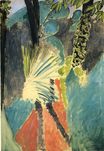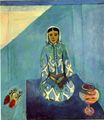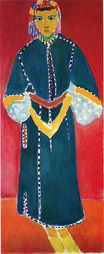Henri Matisse - Zorah Standing 1912
 |
 |
 |
 |
 |
 |
 |

Zorah Standing 1912
146x61cm oil/canvas
State Hermitage Museum, Saint Petersburg, Russia
<< Previous G a l l e r y Next >>
From the State Hermitage Museum, Saint Petersburg, Russia:
In 1913 several important Moroccan works by Matisse appeared in the collection of Moscow collector Sergey Shchukin. Amongst these was Zorah Standing, produced by the artist in late 1912 during his second trip to Morocco. The painting was conceived as a pair to a portrait of the Moroccan boy Amido, also in the Hermitage. Both paintings are on canvas of identical size, and yet the resonance of Zorah Standing makes it a very different work to the portrait of Amido. The whole structure of the painting, its composition and colour, reveal the deep impression made on the artist by Persian miniatures and by Russian icons - he became acquainted with the latter during a journey to Moscow in the autumn of 1911. In Standing Zorah he transformed them, and the artist's favourite model became a symbol of the whole of the mysterious East, full of magic, with the scent of spices in the air. The picture space was subjugated to the flat surface of the canvas. Zorah, wearing dark green, is set frontally and stands out sharply against the bright raspberry-orange background. The white edging with its ornamental black dots introduces a broken rhythmic feel into the almost monotone colour of the figure and reinforces its sense of weightlessness. The transfixing magic of colour, the sorcery in the fixed gaze of those clearly outlined, exaggeratedly almond-shaped eyes - everything embodies the great mystery of the alien culture which provided Matisse with such an intense creative impulse.